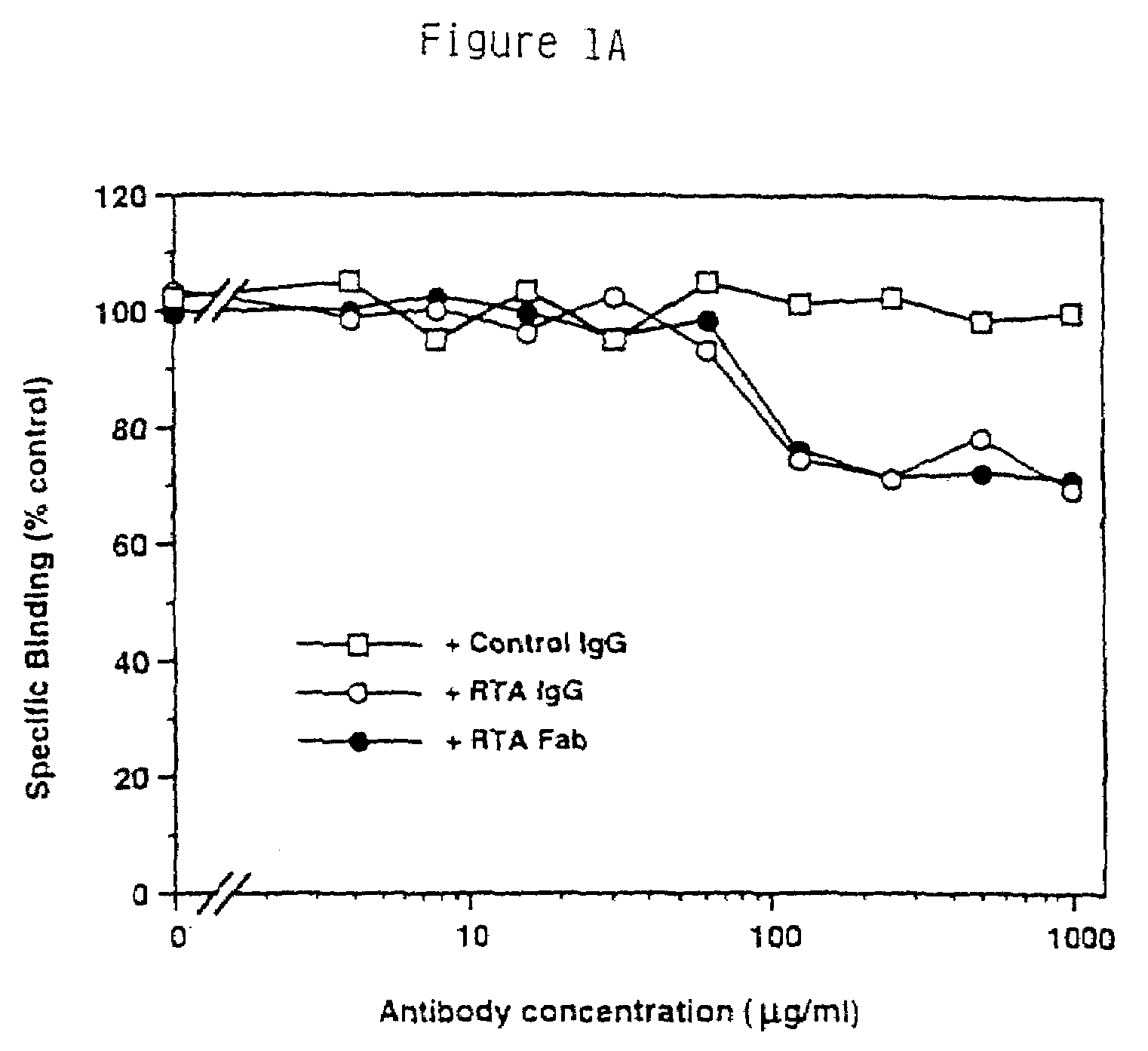Antibodies that mimic actions of neurotrophins
a technology of neurotrophins and antibodies, applied in the field of antibodies that mimic the actions of neurotrophins, can solve the problems of inability to carry out normal function, so as to promote ngf-like cell responses, stimulate receptor activation and cell survival, and improve the understanding of trka and ngf responsiveness in neurons
- Summary
- Abstract
- Description
- Claims
- Application Information
AI Technical Summary
Benefits of technology
Problems solved by technology
Method used
Image
Examples
example 1
Preparation of an Antibody Against the Extracellular Domain of Rat trkA
[0123]To probe the function of the trkA receptor biochemically and biologically, a polyclonal antibody was developed to the extracellular domain of trkA.
[0124]Rabbit polyclonal antisera recognizing rat trkA were generated by using as antigen synthetic peptides derived from the rat trkA amino acid sequence coupled to keyhole limpet hemagglutinin by m-maleimidobenzoylsulfosuccinimide ester (Pierce Chemical Co.). One of the antisera (rtrkA.EX2) was raised against the peptide CSVLNETSFIFTQFLESALTNETMRH (SEQ ID NO: 1) (amino terminal cysteine+trkA amino acids 322 to 346) and recognized the extracellular domain of trkA by immunoblot.
[0125]Another antibody (rtrkA.cyt) was raised against a peptide corresponding to the carboxy-terminal end of the rat trkA receptor (CARLQALAQAPPSYLDVLG; SE ID NO:2; amino terminal cysteine+trkA amino acids 782 to 799) and was subsequently affinity purified on a column including the same pep...
example 2
RtrkA.EX Blocks the Binding of NGF to the trkA Receptor.
[0156]From the immunoprecipitation analysis it was clear that the RtrkA.EX antibody can recognize the native trkA receptor protein. To determine if the antibody could disrupt the NGF-binding activity of the receptor, and therefore serve as an inhibitor of the receptor's function, the following experiments were done. In this series of experiments, the effects of the antibody preparations were tested in NGF binding assays of the PC12 cell line, known to express both the low affinity NGF receptor LNGFR as well as trkA. NGF was purified from male mouse submaxillary gland following the procedure of (Mobley, W. C., Schenker, A. and Shooter, E. M., Biochemistry., 15, 5543-5552 (1976)) or was the gift of W. Mobley.
[0157]Cell culture. PC12 cells (ATCC No. CRL 1721) were maintained in Dulbecco's Modified Eagle's medium (DME-H21) containing 10% fetal calf serum and 5% horse serum on tissue culture plastic. The nnr5 subclone of PC12 (avail...
example 3
RtrkA.EX Fab Fragments Inhibit the Phosphorylation Response to NGF.
[0171]PC12 cells respond to NGF rapidly, and after five minutes of exposure, a reproducible burst of tyrosine phosphorylation of many cellular proteins occurs (Maher, P. A., Proc. Natl. Acad. Sci. USA 85:6788-6791 (1988)). This effect can be measured by probing blots of cell lysates with anti-phosphotyrosine antibodies. In lane 2 several cellular substrates for NGF-dependent tyrosine phosphorylation are detected after five minutes of NGF treatment (arrows), but not in the absence of NGF (lane 1).
[0172]RtrkA.EX Fab fragments block NGF-dependent cellular tyrosine phosphorylation. PC12 cultures were preincubated with 500 μg / ml nonimmune Fab (control, lane 3), RtrkA.EX Fab (RTA, lane 4), or no antibody (lanes 1 and 2), for four hours prior to the addition of 5 ng / ml NGF for five minutes (lanes 2-4). The cleared lysates (10 μg) were fractionated by 10% SDS-PAGE, blotted, and probed for changes in cellular tyrosine phospho...
PUM
| Property | Measurement | Unit |
|---|---|---|
| Dimensionless property | aaaaa | aaaaa |
| Body weight | aaaaa | aaaaa |
Abstract
Description
Claims
Application Information
 Login to View More
Login to View More - R&D
- Intellectual Property
- Life Sciences
- Materials
- Tech Scout
- Unparalleled Data Quality
- Higher Quality Content
- 60% Fewer Hallucinations
Browse by: Latest US Patents, China's latest patents, Technical Efficacy Thesaurus, Application Domain, Technology Topic, Popular Technical Reports.
© 2025 PatSnap. All rights reserved.Legal|Privacy policy|Modern Slavery Act Transparency Statement|Sitemap|About US| Contact US: help@patsnap.com



